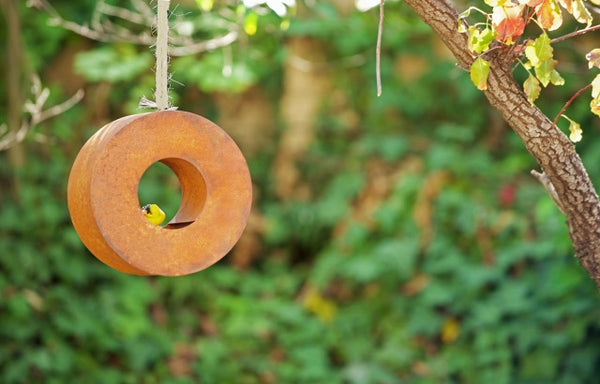
Since we last wrote about our Bee Bungalows and offered ideas to nurture native pollinators in the landscape, we noticed an uptick of interest and sales of our feeders and bungalows. We are thrilled that awareness is growing as to the importance of native birds and bees frequenting backyards and public gardens.

Even in our own yards we’ve noticed that our Bee Bungalow and Bird Cafe are pretty popular places to hang.
Hang…hmm.
And that got us thinking.
Not long after that revelation, we launched our new Hanging Bee Bungalow and Hanging Bird Cafe. Originally, when we designed these two garden pieces, we made them mountable on our Akoris Garden Tuteur. But we knew we were on to something when we hung them from the branches of a tree, admiring the raw steel finish set against nature’s other raw finish—bark. Birds immediately welcomed the hanging sculpture in the garden (a good sign).


Hanging and suspending sculpture can be just as evocative as art that’s mounted on a structure or on the ground, providing an alternate perspective to appreciate its placement (and often movement) within a setting.
Alexander Calder’s (1898-1976) kinetic mobiles are a perfect example of this idea that sculpture can have movement and fluidity. His mobile sculptures (exhibited at MOMA, LACMA and SFMOMA) were the inspiration for other twentieth-century sculptors like George Rickey (The Getty Museum). Some say that Calder’s mobiles alluded to nature’s movement—those of leaves, birds, and insects.
Japanese-American artist Ruth Asawa (1926-2013) created large and intricate suspended crocheted wire structures, among other pieces of sculpture and art. She too found inspiration from nature when she created her wire sculpture, drawing from childhood memories of diverging and converging lines in the sand. Her wire sculptures (exhibited at de Young Museum) were created to be enjoyed from various angles, moving freely within a larger space.
So what does twentieth-century sculpture have to do with Terra Trellis’ hanging habitats?

Nature, art, science, form, and function—the convergence of all these elements was the initial inspiration for our sculpture work. It’s what we think about when we design each new piece. The interplay between our pieces and nature, and how our clients (and garden wildlife) react to this “dance”, keeps us motivated.

We also spent some time hanging out in the garden with our friends Chantal Aida Gordon and Ryan Benoit, the dynamic team behind The Horticult. Chantal and Ryan recently dropped by for a chat and photo shoot of our sculpture garden. The Q & A, which you can read here, was so much fun, and it was great to share some of our new works, like the hanging habitats, and several other new limited edition Terra Sculpture pieces.

We were also thrilled to see our Bee Bungalow hanging under the canopy of a flowering/fruiting tangerine tree in the Horticult's very own garden, near the beach in La Jolla, California. Native bees will soon be moving in to this sculptural habitat, getting to work pollinating all of the wonders growing in the Horticult’s botanical paradise.
